| October 1942 Popular Mechanics |
 [Table of Contents] [Table of Contents]
Wax nostalgic about and learn from the history of early
mechanics and electronics. See articles from
Popular Mechanics,
published continuously since 1902. All copyrights hereby acknowledged.
|
What does the 1942
Popular Mechanics magazine article entitled "Frozen Billions" have to do
with radium, you might reasonably ask? The answer is that the most prolific
radium ore mine is located on a rocky point extending into Great Bear Lake in
the Northwest
Territories in Canada. At the time of the mine's discovery, radium was
selling for $1,960,000 an ounce. This story about Marie and Pierre Curie's
(oddly, not mentioned in the article) 1898 discovery tells the history of the mine as
well as the many applications for radium's gamma ray emissions in industry,
medicine, and the military. Its properties made it worth billions of dollars in
sales, but its value in helping to beat back the Axis Powers in World War II was
priceless. The extreme high penetration of gamma rays (stronger than x−rays)
made it useful for inspecting massive solid mechanical devices like engine blocks,
electric generator housings, ship and airplane motor and transmission housings,
and similar cast metal shapes where internal voids can form. In small doses it
treats cancer, makes aircraft instrument and wristwatch dials readable at night,
a generates low levels of heat. With a half life of 1,690 years, a little radium
goes a long way.
Radium Uses
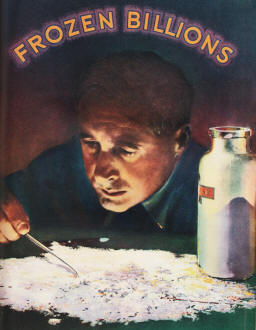
One of man's most precious minerals, radium is of greater value
than ever in a world at war. It is indispensable in therapy, in radio-photography
and in research into nuclear physics; and today it finds use in the blackout. Here
a General Electric scientist experiments with luminous pigments for blackout paints.
By Allen Warren Elliott
If you could stuff your pockets full of hundred-dollar bills, fill your hat,
grab two handfuls and then stagger around with a huge bundle under each arm, it
is possible that you could carry a million dollars. If you could slip a little pellet
of radium into your pocket, a ball about the size of a large garden pea, weighing
around an ounce and a half, you would also be carrying a million dollars.
You wouldn't haul this precious load around very long. First, because radium
plays tricks on the human body. And, second, because Uncle Sam would probably grab
it in a minute and give you 10,000 crisp hundred dollar bills in exchange. For radium
is now a vastly important war material.
The planes which fill the skies, the ships which plow the sea, the tanks, the
guns, even the shells and bombs, all require radium somewhere along the line.
If regular nightly blackouts come to your community, you will probably require
it too, for radium is the luminous paint factor which needs no light to make it
shine in the dark year after year. Radium may even conceivably save your life before
the war is over, since being hit by a blacked-out automobile is just as likely to
be fatal as being struck by a bomb fragment.
Timed as if to meet the emergency need, a fantastic stroke of luck has placed
practically all of the world's supply of available new radium in the control of
the United Nations.
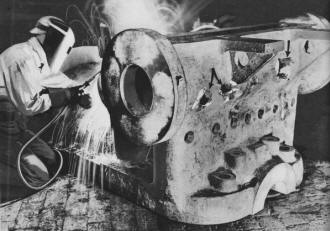
A welder fills in areas chipped from steel turbine costing (note
arrows) after gamma rays had detected air-bubble flows in steel.
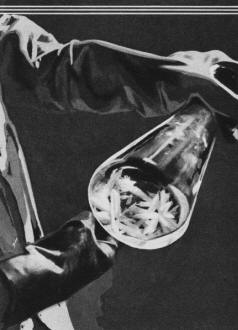
White crystals of radium bromide appear in colorless liquid during
final stage of re-fining by Canadian Radium & Uranium Co.
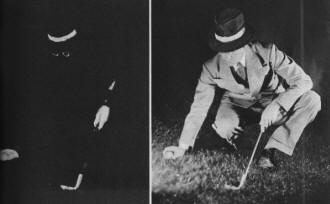
Ever play "spook golf?" It's a game invented, as a stunt, by
General Electric engineers experimenting with luminous paint for use in blackouts.
At the right the golfer is photographed by flashlight; at left, he's in a blackout.
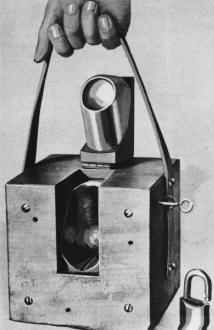
Radium sulfate, the source of the powerful gamma rays, is never
handled directly. When needed for inspecting metals, it is brought from its sunken,
lead-lined safe in this carrier, also lead-lined
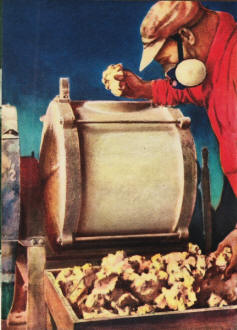
Grinding sodium uranate, a heavy, bright yellow, clay-like substance
to be used as pigment. This is a common form of uranium, heaviest element and parent
of radium
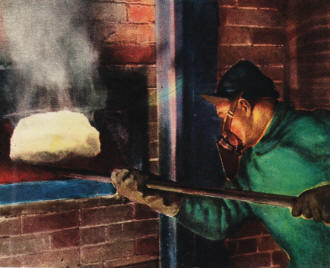
The first step in refining radium, as in treating many other
ores, is to roast out impurities in the furnace. This is a scene at Eldorado refinery,
Port Hope, Ont.
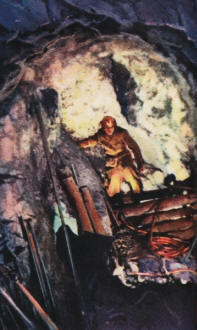
Mining radium-bearing ore 500 feet under the earth, a slope in
the Eldorado Mine on the edge of the Canadian Arctic. The ore vein which contains
the radium is pitch-blende-a dull heavy, black and brittle rock.
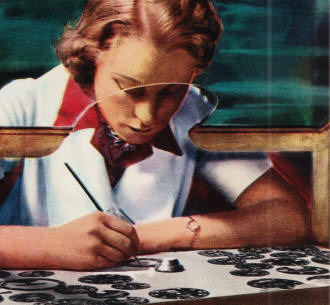
One important use of radium in war is in the making of luminous
compounds. Here a worker paints aircraft instrument dials with a radium compound
which makes them easily read in a dark cockpit.
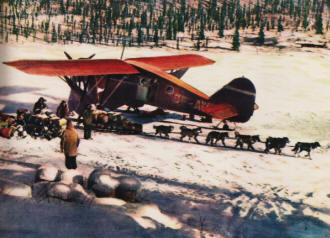
The airplane and the dog sled, the new and the old, provide the
only means of reaching the outside world during the long winter at Eldorado on Great
Bear Lake, "world capital" of radium production.
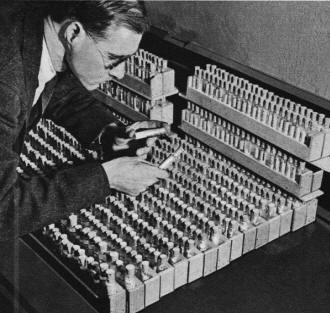
Hundreds of luminous chemicals are being studies at the General
Electric laboratories for possible blackout use.
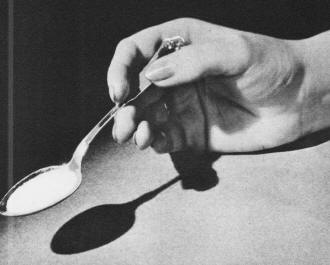
A teaspoon about two-thirds full represents an average pre-war
year's supply of radium salts in the United States.
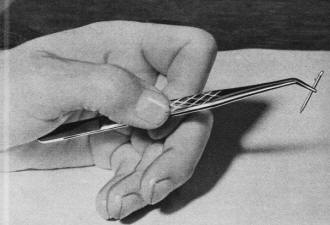
A needle of this size, used in radiotherapy and particularly
for cancer treatments, usually contains $600 to $1,000 worth of radium.
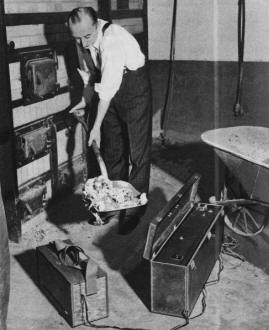
Frank Hartman, Philadelphia "radium detective," hunts lost radium
in ashes from hospital incinerator with his "electric bloodhound."
Providential, too, was the whim of fortune by which the mine that disgorges 99%
of this radium was discovered through two pairs of human eyes, one pair sharp and
curious, the other pair swollen and snowblinded. Else the anti-Nazi world would
have practically no new radium right now when it is needed.
The chain of fortunate circumstances held together, however, and today in a 10,000-acre
spot of bleak ground in northern Canada, only 26 miles from the Arctic Circle, deep
in the frigid rocks, men are mining this critical supply of radium ore. It is worth
many, many millions, and for all anyone can say with certainty, this treasure is
likely to prove to be literally frozen billions.
By dog sled, tractor train, plane, boat and rail huge supplies of this fascinating
substance are being rushed from the Arctic Circle to New York City, from where the
radium trickles in pin-point quantities throughout the United Nations. So scattered
is the product in its natural state and so thinly can it be spread when purified
that a huge supply of the ore, say 500 tons, finally becomes a quantity which could
be hidden under a fingernail if unadulterated. And still this remains a huge supply.
Night and day in the depths of the radium mine on a rocky point extending into
Great Bear Lake in the Northwest Territories, miners dig the black and brittle pitch-blende.
Night and day at Port Hope, near Toronto, Ontario, experts refine the concentrated
ore. And night and day in New York City chemists complete the processes bringing
the radium down to a point of purity where a thimbleful, still heavily diluted,
might fill dozens up-on dozens of industrial war orders.
It all goes back 12 years to a romantic episode concerning the two pairs of eyes
and a twist of fate which attracted little attention outside Canada at the time.
Only now has it grown to world importance.
The hero who found this richest piece of rock in the world is a hardy French-Canadian
prospector, Gilbert LaBine, who searched the snowy wastes year after year for "pay
dirt." Not only his sharp eyes led to the strike, but also his honesty.
LaBine finally struck silver in sufficient quantities to make a stake, took this
money, interested a group of investors and formed the El-dorado Gold Mines, Ltd.,
to work some claims in the Long Lake District of Manitoba. One day, while the investors
were all waiting for word which would make them wealthy, LaBine called them together
and laid his cards on the table. The property, he confessed, was a failure. They
would have to make another strike. Disappointed, his backers told him to try.
Hiring a plane and a pilot, he flew to the Great Bear Lake region. It had only
been visited by Arctic explorers, a few Indians and Eskimos and an occasional white
fur trapper, but somehow had become the focus of a tale of vast mineral wealth.
He tramped across the snow and ice, questioned an Indian and his squaw who had camped
on the lake shore, found nothing definite and soon returned to civilization. There
might be fabulous veins of metal around Great Bear Lake, as the tales said, but
unfortunately the lake was one of the world's largest.
Waiting a year, he tried again, taking another prospector with him, Charlie Saint
Paul. Landing their plane on the frozen lake, they rigged up a sled and began exploring
the shores, hauling 1,200 pounds of food and equipment in terrific cold, 20 to 45
degrees below zero.
Finally they reached a promontory that is now LaBine Point. They were thinking
of giving up the search even though they had found outcroppings of silver. Silver
was too cheap to be transported back to civilization from the top of the world.
They would have traded a million tons of the silver ore on the spot for a hot apple
pie.
It might have ended there, except that Saint Paul awoke one morning blinded by
the glare of snow and ice. While waiting for his companion's eyes to heal, LaBine
remembered a strange black streak which had caught his eye while flying over the
promontory. Working his way over the ice and rocks, picking at the outcroppings,
LaBine came upon a patch of what looked like coal, but was infinitely harder. He
recognized it for pitch-blende, the parent ore containing radium, uranium, silver
and a number of other valuable minerals.
Before long the pair were winging south with ore samples. Chemists confirmed
its value. The Canadian government sent an air expedition to the site of the strike.
They verified the huge extent of the ore field.
Still, Gilbert LaBine and his investors had to wait for their riches.
While radium was then selling for $1,960,000 an ounce there were many tantalizing
factors. It was so costly that only the biggest institutions could buy minute quantities
for its principal use, cancer treatment. The Belgians had a stranglehold on the
world market with easily accessible ore in the Congo and refineries in Belgium.
The nearest railroad ended 765 miles from Great Bear Lake. The only water route
was open six weeks to two months of the year and rapids forced two overland portages.
Huge quantities of ore had to be hauled to the nearest available coal or oil for
concentrating, or the fuel had to be transported into the Arctic.
The jump from Great Bear Lake to the logical refining point was about 4,000 miles.
To refine each ton of pitchblende even after it is concentrated requires five tons
of chemicals. And to top it all, no one could be found on this continent to tell
them how to extract the precious product, radium, from this particular ore.
"Then began a struggle which lasted years before results began to show," says
Boris Pregel, president of the Canadian Radium and Uranium Corporation. "Gradually
the machinery was shipped up there, largely by plane. The mine was dug. A mining
town was built. A water transportation company was established. A plane service
was inaugurated. A refinery was built near Toronto. A Frenchman named Marcel Pochon
was located in the mines of Cornwall, in the British Isles, who knew what to do
with the ore.
"As soon as the money started to come in, we cut the price approximately in half
to broaden the market. Then the war struck and Germany took over the Belgian refineries
while the Allies kept the Congo mines. This blocked the former principal source
of radium and soon we found the entire civilized world depending upon us.
"Now, with this responsibility, we are no longer working for money. We are working
to win the war."
Radium is being used more widely than ever for therapy, including cancer treatment,
for research into nuclear physics which change the whole pattern of future living
and for luminous pigments necessary for airplane, submarine and warship dials as
well as blackouts. But its value for radiography, or photography by means of its
radiations, is its key purpose right now.
Remarkable enough is its ability to bombard zinc sulphide with 183,000,000 particles
a second and thus give off a glow in luminous pigments that lasts an average of
10 years, or till the zinc is exhausted.
Even more fortunate for the war effort is the fact that the gamma rays of radium
will penetrate eleven inches of toughest steel and make an impression on a film
in which a flaw, such as an air hole, will show up black on, the film and white
on a photograph.
Great corporations like General Electric, General Motors and Westinghouse, and
hundreds of others, are soaking up the supply in increasing volume, to take radiographs
of castings, boilers, plates, etc., to correct hidden flaws so the final product
may be perfect. Munitions factories use radium bombs to see through shell casings
and eliminate duds from the munitions on which American troops and sailors will
depend in battle. Ship building corporations and steelmakers examine their war products
by this method. A radium bomb the size of a small walnut can replace a roomful of
machinery necessary for X-rays and the radiations flow in all directions, not merely
in one.
Typical is the Westinghouse Steam Division Works at Lester, Pa., where these
"pin point power plants," minute grains of radium sulfate, are at work inspecting
war equipment as it is produced. Radium sulfate is used especially to examine parts
of steam turbines, propulsion gears and auxiliary apparatus for our fighting ships.
This plant has a supply of radium sulfate with which to test propulsion turbines
and gears for destroyers, cruisers, battleships and aircraft carriers, and a lot
of other things.
N. L. Mochel, manager of the Metallurgical Engineering Department at the Westinghouse
Works, describes radium sulfate as "nature's most efficient power plant."
"The compound resembles slightly discolored table salt," Mr. Mochel explained.
"The atoms split spontaneously. This perpetual disintegration generates gamma rays
which pierce the hardest steel. Flaws in the metal appear on the film as dark areas.
The rays are able to reach the film with greater intensity during an exposure period
through flaws than through solid metallic structure.
"Even though it decays to produce energy, radium sulfate is a constant power
source. Had a scientist of the fourth century isolated a bit of radium sulfate,
it would have reduced itself only to half strength by 1942."
When a piece of equipment is brought into the laboratory for inspection, a technician
fishes a radium capsule out of a sunken safe. The walls and bottom of the safe are
four-inch slabs of lead. Inside is a block of lead with small wells to hold the
radium sulfate containers. A lead lid locks into place over the safe. Radium sulfate
must be handled with extreme care. The laboratory is lined with lead. Workmen never
remain more than a minute or so in the vicinity when a capsule is exposed.
Displaying a small pear-shaped aluminum shell, Mr. Mochel explained that four
particles of radium sulfate were enclosed in similar containers. The shells contain
tiny silver kernels in which the substance is sealed. The four metal "nuts" would
fit easily in the palm of one hand.
"The capsules are suspended within or beside the metal being tested," he continued.
"As many as 20 films have been taken in the Westinghouse laboratories at the same
time. A belt of film can be placed around circular pieces of metal, such as pipe.
These plates register gamma rays from a single radium sulfate source fixed in the
center."
Exposure times vary from a few minutes to 48 hours, Mr. Mochel said. Time of
the exposure is gauged by using a special slide rule, developed by Navy engineers.
It is estimated that each gram of the substance has 2,680 billion billions of atoms
which can be kept working for about 20,000 years, the substance losing half of its
life every 1690 years. It can't be burned by 2,000 degrees of heat, it can't be
broken down by pounding, it won't freeze and it is pretty hard to lose. Electric
"radium bloodhounds" have been invented to trace it by its radiations. Lost capsules
have been found in a pig's stomach and inside a cement sidewalk.
Gilbert LaBine's mine will be working for America a long time, and the experts
who once thought in milligrams are now thinking in grams. Soon they will be thinking
in terms of ounces and eventually perhaps pounds of radium.
It's nice to think about a pound of radium. It would be quite a bit smaller than
a tennis ball and would be worth nearly eleven and a half million dollars, f.o.b.
New York City.
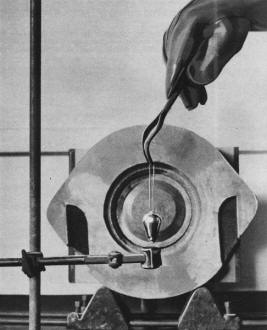
Making a radiograph of a metal casting with radium encased in
aluminum "bomb."
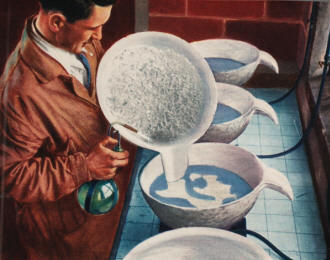
Crystals in this quartz bowl ore barium-radium - all that remains
after refining many tons of are from the subarctic. Impurities have been removed.
and barium is being separated out.
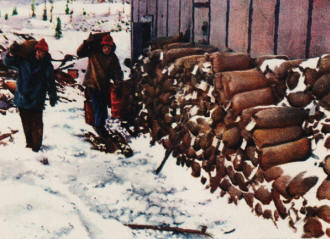
Concentrated radium ore ready for refining, is packed in bags
like this at Port Radium - airport a few miles from the mining community - to await
air shipment to refinery near Toronto.
Posted January 23, 2024
|



























